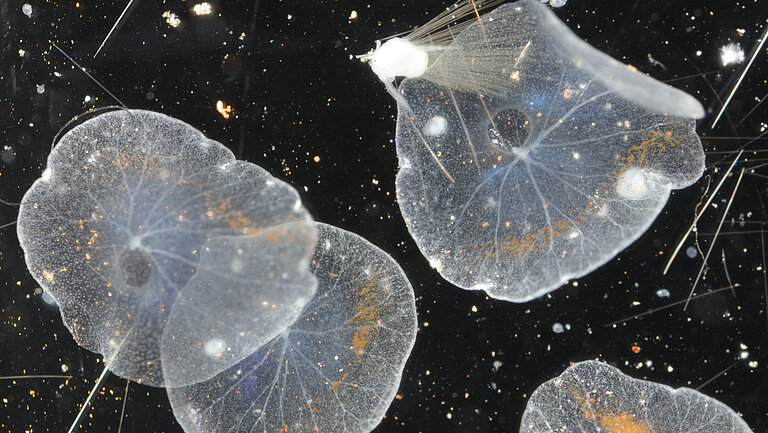Shedding Light on the Ocean’s Twilight Zone
EU Twinning Project to Investigate Deep-Sea Food Webs around Madeira
The deeper one descends into the ocean, the less sunlight penetrates the water. Between 200 and 1,000 metres, only residual light remains, which is why this region is referred to as the ‘Twilight Zone’. Life in the twilight zone includes bacteria, zooplankton including many species of gelatinous animals like jellyfish, as well as fish, squids, and deep-diving whales. “Life in the Twilight Zone is still largely unexplored, including the diversity of species, and the feeding interactions among them,” states Dr Jan Dierking, marine biologist at GEOMAR who is particularly interested in marine food webs. Together with his colleague Dr Henk-Jan Hoving, head of the Deep-Sea Biology Group at GEOMAR, he will now team up with international partners in the new TWILIGHTED project to shed light on the elusive twilight zone around Madeira.
Kick-off for EU Twinning Project on Madeira
TWILIGHTED is a Twinning project funded by the European Union (EU) under the Horizon Europe research and innovation programme with a grant of €1.5 million. It officially launched yesterday with a kick-off meeting in Funchal, Madeira. The name TWILIGHTED stands for Twinning Laboratory for an Innovative Global Hub to Explore the Deep. Twinning projects are transnational partnerships projects in which research institutions from less-economically developed regions in Europe benefit from capacity transfer from leading institutes in the research field. Within the framework of TWILIGHTED, GEOMAR and the Norges Teknisk-Naturvitenskapelige Universitet (NTNU, Norway) will work closely with the marine science institute MARE Madeira (ARDITI, Portugal).
“Jellyweb Madeira” expedition provides data basis
Leading up to this project, in February-March 2024, the expedition MSM126 “Jellyweb Madeira” with the large German research vessel MARIA S. MERIAN already investigated the underwater ecosystems around Madeira using GEOMAR’s ROV PHOCA, camera systems, water samplers and nets, and various oceanographic sensors. “Our samples and datasets from the ‘Jellyweb Madeira’ expedition are now available to support training and scientific exploitation within TWILIGHTED,” says Dr Dierking.
Creative ideas for cost-effective deep-sea technologies
One of the key aims of deep-sea research in Madeira is to develop simpler and more cost-effective technologies that can also be deployed from smaller vessels, but also to introduce partners to the technology and data handling pipelines we use at GEOMAR. For this, there will be close collaboration with GEOMAR’s Technology and Logistics Centre (TLZ) and the GEOMAR data and sample management teams. In the summer of 2025, researchers from Madeira will visit GEOMAR to be trained in modern analysis methods such as e-DNA sampling, analysis and data interpretation and food web analysis using stable isotopes. Another important topic is the collection and curation of images and image data. In addition to addressing scientific questions, the project also aims to strengthen Madeira as a research location and to make deep-sea research in Portugal accessible to a wider audience.
Strengthening Madeira as a research location
This is reflected by the vision of the TWILIGHTED project coordinator Dr João Canning-Clode, MARE-Madeira, who believes that “the TWILIGHTED project marks the beginning of a transformative journey for Portugal, fostering creativity and using low-cost technologies in deep-sea research, redefining the country's role in understanding and protecting these vital deep-sea ecosystems.”
Funding:
The TWILIGHTED project (Twinning Laboratory for an Innovative Global Hub to Explore the Deep) is funded under the European Union’s Horizon Europe research and innovation programme with 1.5 million euros over three years (Grant Agreement No. 101158714).

Colourful and beautiful: Many species in the twilight zone are still unexplored. Photo: Karen Osborn, Smithsonian

Scientists from Germany, Norway and Portugal have joined forces in the TWILIGHTED project to shed light on the ocean's still mysterious twilight zone. Photo: Karen Osborn, Smithsonian

To study deep-sea food webs, the Jellyweb Madeira expedition deployed a baited deep-sea lander at a depth of 1500 metres. The data from this expedition will now also be used to support the TWILIGHTED training programme. Photo: ROV-PHOCA team GEOMAR


